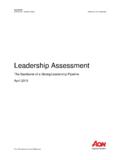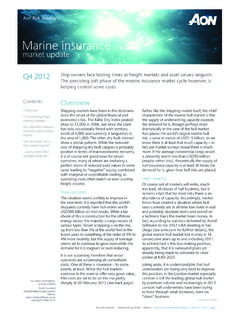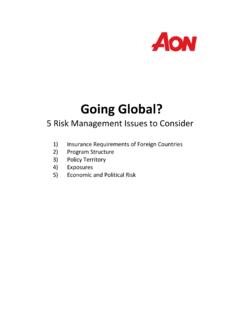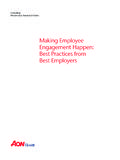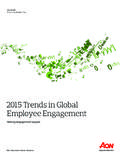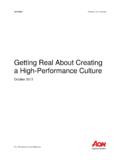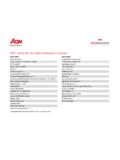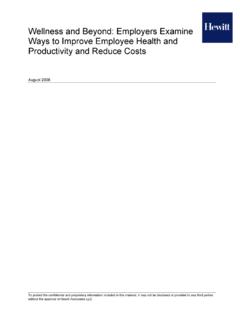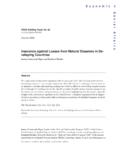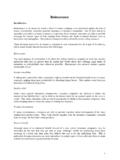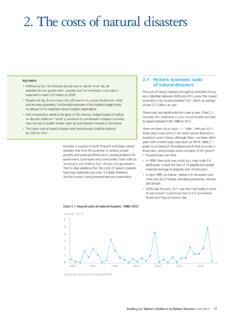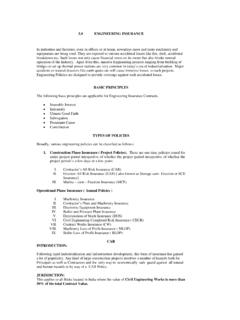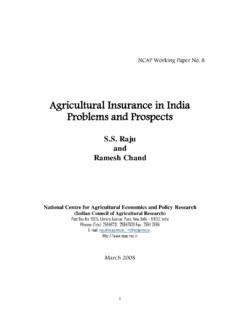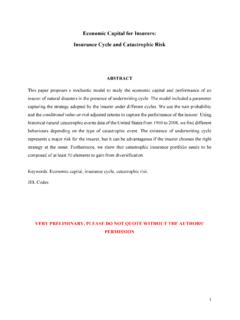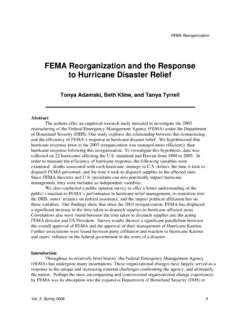Transcription of Large Exposure Property Losses | Aon
1 Large Exposure Property LossesThe Right Expert Will Make a Difference Concepts and Recent Developments August 2011 Frank Oliver, ARM Aon Risk Solutions / Global Risk Consulting / Property Risk Consulting 2011 Aon Corporation Aon Risk Solutions | Aon Global Risk Consulting | Property Risk Consulting Proprietary & Confidential Introduction The complexity of Property insurance claims has changed dramatically in the last few decades. This change can largely be attributed to the increase in and significance of exposures carriers have faced from natural and man-made disasters, as well as the increasing complexity associated with these types of claims.
2 This gradual but certain increase in complexity has resulted in the availability and types of coverage, and has directly impacted the claim resolution process. One of the most significant changes we have witnessed is the trend by carriers to limit their risk when underwriting certain types of Losses and the routine retention of teams of experts to direct the adjustment process of complex and/or catastrophic Property claims. As the saying goes, in order to understand the present, we must look to the past. In this paper, we will provide an overview of and outline the significant events which have prompted changes in coverage, adjustment and claim preparation procedures, and settlement of commercial Property insurance claims, with an emphasis on business interruption.
3 By identifying the emerging trends of past decades, we can gain key insights on ways to prepare for and resolve Losses going forward. A firm understanding of current issues can enable risk and financial leaders to more proactively plan their claim approach, mitigate damages and maximize coverage and ultimate recovery.. Historical Overview of Large Exposure and Complex Claims Over the past decades, the number of natural catastrophes has risen steadily, specifically those stemming from atmospheric events including named hurricanes Katrina, Andrew, and Wilma. As depicted in the graphs below, both the frequency and severity of Losses have increased significantly, with the largest impact occurring over the past 25 years.
4 This increase in storm frequency -- and the resulting insurable damages -- was so significant that insurers began to classify named storms, floods, and other Large -scale Losses as catastrophic events. In turn, as these potential insurable damages increased, both coverage and the insurance claims process were impacted. The impact on the policyholder from Property loss, diminution of its value, business interruption or other financial loss, can be catastrophic. The increase of insurable interests in these disasters and other Large Exposure Losses directly precipitated changes within the market, which we discuss below. Notably, the most costly disasters in history occurred within the past two decades, and eight out of ten of these events occurred in this decade alone.
5 This trend is expected to continue, creating even greater challenges for firms seeking to manage their risk. Aon Risk Solutions | Aon Global Risk Consulting | Property Risk Consulting Proprietary & Confidential 1 In December 2010, Tropical Storm Risk (TSR), part of Aon Benfield Research s new academic and industry collaboration, issued its forecast for the 2011 Atlantic Hurricane Season advising Atlantic hurricane activity will be approximately 40% above the long term norm in 2011 .1 As such, it appears that the trend will continue; and more significantly, it portends higher costs as greater frequency of hurricane occurrence is expected.
6 Already, insurance markets have become inundated with non-hurricane catastrophic events for 2011: Australian floods (January), New Zealand earthquake (February), Japan earthquake and tsunami (March) and severe tornadoes (May). In addition to these naturally caused catastrophic Losses , the insurance market also faced significant Exposure due to several Large -scale fires, explosions, and building collapses which occurred in the 1980 s. However, it was the attacks of September 11th in 2001 and the occurrence of Hurricane Katrina in 2005 that substantially impacted the carriers claim handling processes; specifically as they relate to business interruption claims.
7 1 Saunders, Mark. "Extended Range Forecast for Atlantic Hurricane Activity in 2011." Tropical Storm Risk (Dec. 2010): 1-4. Tropical Storm. Aon Risk Solutions | Aon Global Risk Consulting | Property Risk Consulting Proprietary & Confidential 2 Given the significant Exposure facing carriers, along with the increase in severity and complexity of claims, precise and detailed documentation, along with increased specialization, have become the norm. Attorneys, forensic accountants, engineers, building estimators, and many other experts are now employed by carriers at the onset of a claim to adjust and direct the claim process.
8 With the assistance of these experts, carriers are now requesting greater and more precise documentation from policyholders to support their claim payments. To illustrate, the Property /Casualty insurance Industry Income Analysis for 2005 2009, shows loss adjustment expenses incurred exceeded 20% of the total claim These costs are in part due to the involvement of experts in the loss adjustment process. Further, these Large and complex Losses not only affected the claim process, but also precipitated changes in insurance underwriting and deductibles. 2 "Industry Overview." insurance Topics.
9 insurance Information Institute , 2010. Aon Risk Solutions | Aon Global Risk Consulting | Property Risk Consulting Proprietary & Confidential 3 Changes and Current Trends in insurance Coverages and Deductibles natural disasters and other Large Exposure Property Losses have compelled insurance carriers to take a more prudent and restrictive approach when assessing their potential risk. Carriers began to limit coverage for Named Windstorms, Earthquake, Flood and other catastrophic events by applying sublimits3 and percentage deductibles4. Policy review should address applicable sublimits and percentage deductibles, both during the marketing and broking processes, as well as when a claim occurs.
10 Simply stated, the policyholder will retain a larger portion of the risk due to these percentage deductibles and policy sublimits. As is becoming more common, one of the most difficult components of a loss to quantify is the period of interruption or restoration and assessing the consequential business income, which are fact intensive. Carriers customarily employ forensic accountants to properly evaluate business interruption5 Losses . Business interruption policies tend to restrict coverage to a specified timeframe which is linked to the period of interruption or restoration6. For some policies, the period of restoration is defined as the period of liability7.
